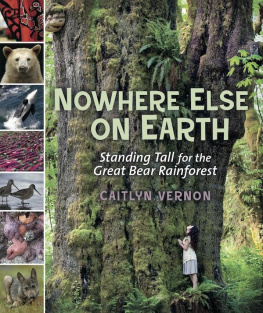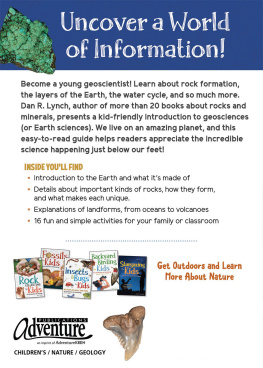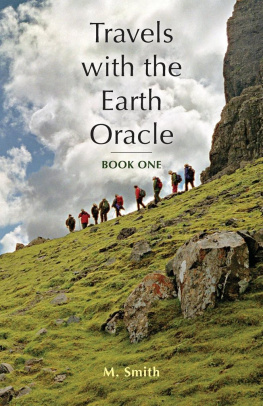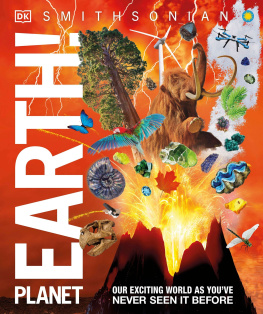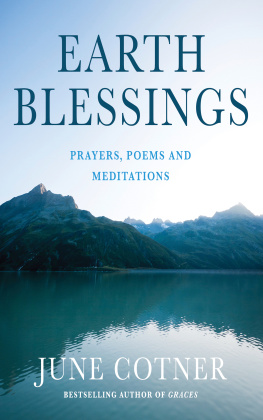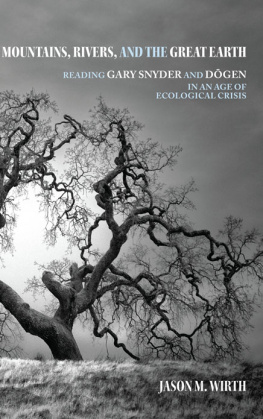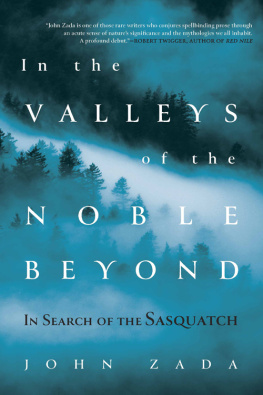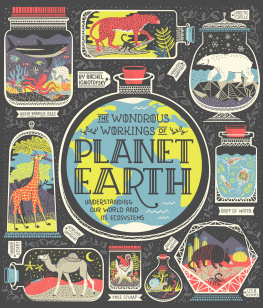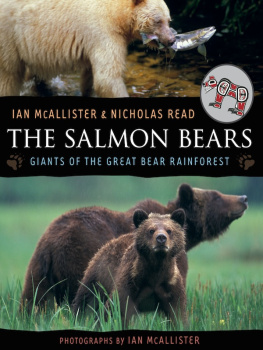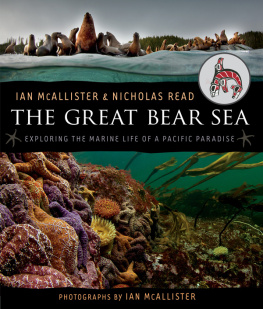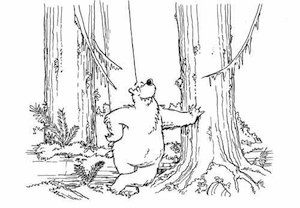Caitlyn Vernon grew up on British Columbias Pacific coast and now calls Victoria home. She will never be too old to wade in the ocean in her gumboots, poke around in tide pools, explore coastal forests or climb trees and mountains. Caitlyn has a background in biology and environmental studies and is currently a campaigner with Sierra Club BC, working to protect the Great Bear Rainforest. Nowhere Else on Earth is her first book.
Acknowledgments
Living at the edge between land and sea has shaped me and shaped this book. I give thanks to my parents, Maggie and Phil, for putting me in kayaks and hiking boots at a young age, opening my eyes to the wonders and the struggles of the world, and believing in me.
Thank you to everyone who has welcomed me into their communities in the Great Bear Rainforest. To those of you who have shared your stories in this book, my deepest gratitude. I am humbled by the strength and generosity and spirit of all who work to sustain the cultures and protect the ecosystems of this coast. It is an honor to know and work with you.
Thank you to the many people who supported and encouraged me throughout the long process of writing this book. Your patience has been remarkable, and much appreciated. Thank you to everyone at Orca Book Publishers for offering me this opportunity and putting so much effort behind my words. Special thanks to my editor, Sarah Harvey, for her gentle guidance and hard questions, and to Teresa Bubela and Nadja Penaluna for making the book look amazing. Thank you to my colleagues at Sierra Club BC: you inspire, you cheer me on, and I am so grateful for all the support. A big thank-you to everyone who reviewed all or parts of the book, answered questions and provided feedback: Maggie Ziegler, Phil Vernon, Erin Griffiths, Colin Campbell, Lisa Matthaus, Jens Wieting, Audrey Roburn, Andy MacKinnon, Ian McAllister and Sonora Godfrey. Special thanks to Jess Housty and Lynne Hill. Any factual errors are my own.
Beyond words, images show how special the Great Bear Rainforest truly is. Thank you to all of the photographers who have so generously provided such stunning and beautiful photos. Special thanks to Douglas Neasloss (dougneasloss.com), Marven Robinson, Andrew S. Wright (cold-coast.com), Thomas P. Peschak (www.thomaspeschak.com), Cristina Mittermeier (cristinamittermeier.com), TJ Watt (utopiaphoto.ca), Mike Ambach (mikeambach.com), Jens Wieting, Ian McAllister, Jared Hobbs (hobbsphotos.com), Qqs (Eyes) Projects Society, Greenpeace, Save Our Seas Foundation, and the International League of Conservation Photographers. Thanks also to Robert D. Turner, Sarah Turner, Daniel Beltra, Chip Vinai, Miles Ritter, Marshall Maher, Mark Worthing, Kate Brauer, Morgan Hocking, Scott Rehmus, ZoAnn Morten, Wayne Worden, Paul Nicklen, Brian Van Wyk, Kiku Dhanwant, the Haida Gwaii Local Foods Processing Co-op, Sierra Youth Coalition, Frances Litman and the family of Nonnie Florence Davidson. Thank you to Dave Leversee for making the maps, and to everyone who helped me find photos, especially Nori Sinclair, Aube Giroux, Jess Housty and Lynne Hill.
Finally, my appreciation and gratitude to everyone out there who is working to make this world a better place to live; you know who you are. You inspire me and give me hope for the future. Together we stand tall.
CHAPTER ONE
The Great Bear Rainforest
Every morning I awake torn between a desire to save the world and an inclination to savor it. This makes it hard to plan the day. But if we forget to savor the world, what possible reason do we have for saving it? In a way, the savoring must come first.
E.B. White American author (18991985)
Where Is the Great Bear Rainforest?
located on the central and north coast of British Columbia (BC). It stretches from just above Bute Inlet all the way up the coast to the bottom of the Alaskan Panhandle. The Great Bear Rainforest covers an area about the size of Switzerland.
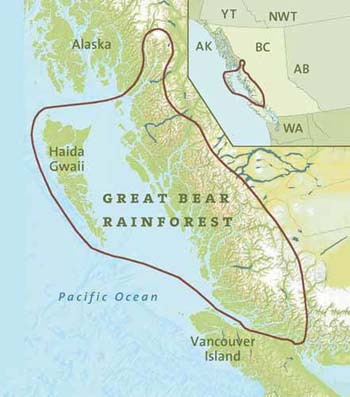
Between the mountains and the ocean lies BC's Great Bear Rainforest.
A Coastal Temperate Rainforest
There are many different kinds of forest on this planet. On the east coast of North America there are all year round and is called the coastal temperate rainforest. Globally, this is an extremely rare type of forest. Even before any industrial logging took place, coastal temperate rainforests covered less than 0.2 percent of the Earths land surface.
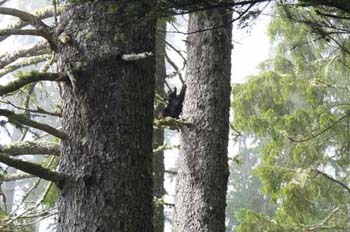
A black bear cub climbs a spruce tree.
JENS WIETING
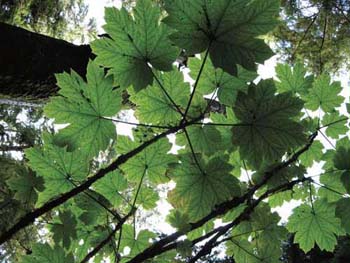
Devil's club has sharp spines and can be used as medicine.
CAITLYN VERNON
Coastal temperate rainforests are only found along the west coasts of continents. Countries with this kind of forest include Canada, the United States, Chile, New Zealand, Australia, Norway, Taiwan and Japan. Many of these forests around the world have been logged. The Great Bear Rainforest contains the largest unlogged coastal temperate rainforest in the world.
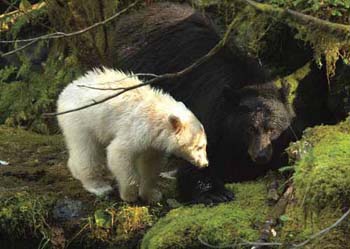
In the Great Bear Rainforest, some black bears have spirit bear cubs.
DOUGLAS NEASLOSS
Big Ancient Trees
BCs coastal temperate rainforest is home to some of the oldest and largest trees on Earth. Two of the top five tallest types of trees in the world grow here: the coastal Douglas-fir and the Sitka spruce. On the west coast of North America, western red cedars and yellow cedars can live up to about 2,000 years. One yellow cedar in southern coastal BC is known to be 1,835 years old. The trunks of western red cedar trees can be as wide as 6 meters (20 feet) in diameter. Just outside Vancouver, a 126-meter (415-foot) Douglas-fir was chopped down in 1902. That tree was 38 stories high!
DID YOU KNOW?
Shake hands with a tree
You can identify a tree by its bark, needles, cones and the shape of the tree itself. For example, if you shake hands with a young spruce, by grabbing a branch, the needles feel sharp and prickly. In comparison, the branches of a western hemlock feel soft to the touch. But western hemlocks can be most easily identified by looking at their tops, which droop over as if a bird has just been sitting on it. A red cedar is known by its stringy bark and flat needles. And Douglas-fir cones are easy to identify. Under each scale it looks as if a mouse ran in to hide, with just its back legs and tail sticking out. Wherever you live, the trees will have characteristics that you can learn in order to tell them apart.
Plenty of Plants
Massive trees covered in thick green moss arent the only plants in the rainforest. There are also tasty berries, edible plants and plants that can be used for medicine. There are plants that sting you, plants that poke you with their sharp spines, and others with leaves so soft you can use them as toilet paper. There are plants that existed during the time of the dinosaurs. There are plants so small and delicate you have to look hard to notice them, and others with leaves so big they block the sun and the rain.

